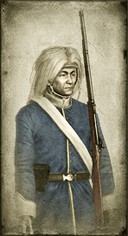
Basic Unit Statistics (can be modified by difficulty level, arts, skills, traits and retainers)
| Recruitment Cost | 990 | |
| Upkeep Cost | 130 | |
| Melee Attack | 6 | 17% |
| Charge Bonus | 15 | 30% |
| Bonus vs Cavalry | 5 | 16% |
| Range | 125 | 19% |
| Accuracy | 40 | 40% |
| Reloading Skill | 35 | 35% |
| Ammunition | 15 | 18% |
| Melee Defence | 4 | 11% |
| Armour | 2 | 13% |
| Morale | 8 | 16% |
Strengths & Weaknesses
- Good accuracy and reload rate.
- Average in melee.
- Weak against cavalry.
- Good morale.
Abilities
- Kneel Fire - The first rank of this unit will kneel to allow the first two ranks to fire simultaneously.
- Suppression Fire - This ability increases reload rate but lowers accuracy. Enemy units hit by suppression fire are slowed and suffer a morale penalty.
Requires
Description
The White Bears are line infantry, trained in the ways of modern battle.
Armed and equipped in the latest foreign style, but wearing a form of traditional white-haired "wig", the White Bears are the staunch defenders of Choshu. As line infantry, they have been trained to deliver disciplined volleys of rifle fire into enemy formations. The foreign-made rifles they carry do terrible damage, and the White Bears are both accurate and rapid firing with them. They are well motiviated and have good morale, but they not really experts in close-quarter fighting. Similarly, like other infantry, they will be ridden down by cavalry if left in an exposed position. One of the most famous weapon designers in Japan was a son of the Choshu domain. Born a samurai and adopted by a gunmaker, Arisaka Nariakira eventually became a lieutenant general in the Imperial Japanese Army. He was also ennobled as a baron by the Emperor Meiji for his work in developing infantry weapons. While his first efforts were not well regarded by the troops who had to use them, he learned from his mistakes, and his guns were in use by Japanese troops during the Boxer Rebellion (1900), the Russo-Japanese War (1904-5) and throughout the Second World War (1939-45). He also designed artillery pieces for the Imperial Japanese Army. His grasp of advanced engineering and ballistics is even more remarkable when you remember that he was born into what was essentially a non-technical, medieval society. In the space of his lifetime, Japan went from being a closed, traditional society to a modern power, virtually the equal of any contemporary, colonialist European nation.